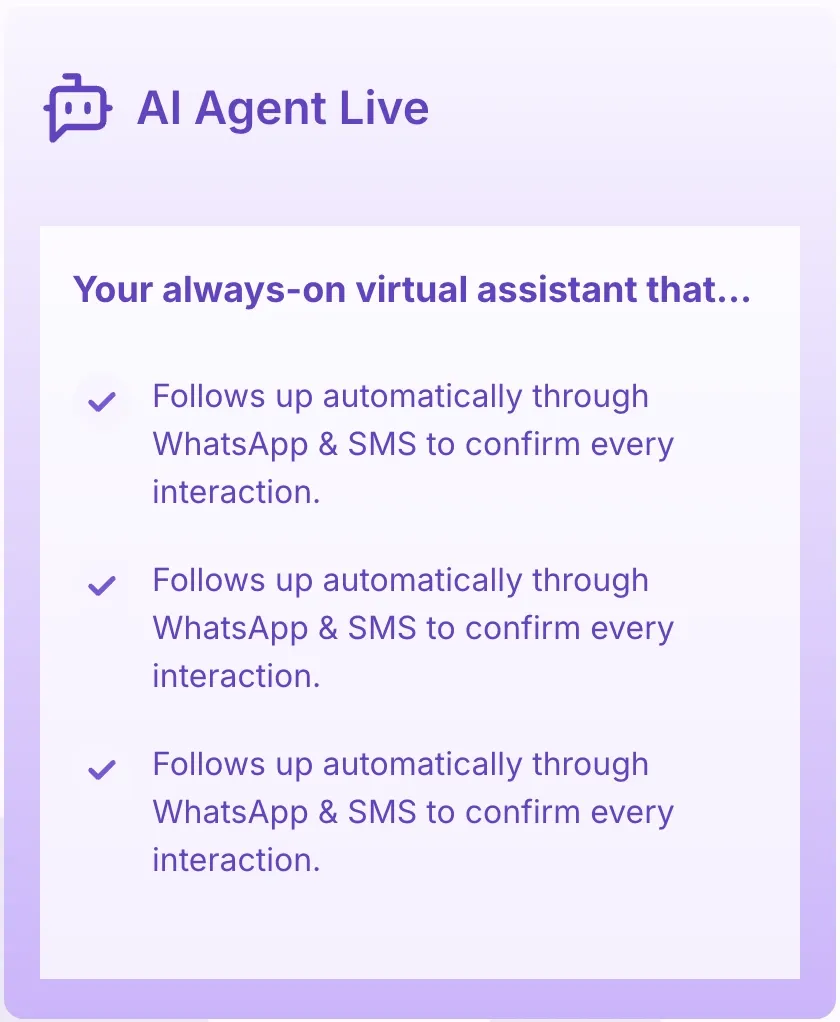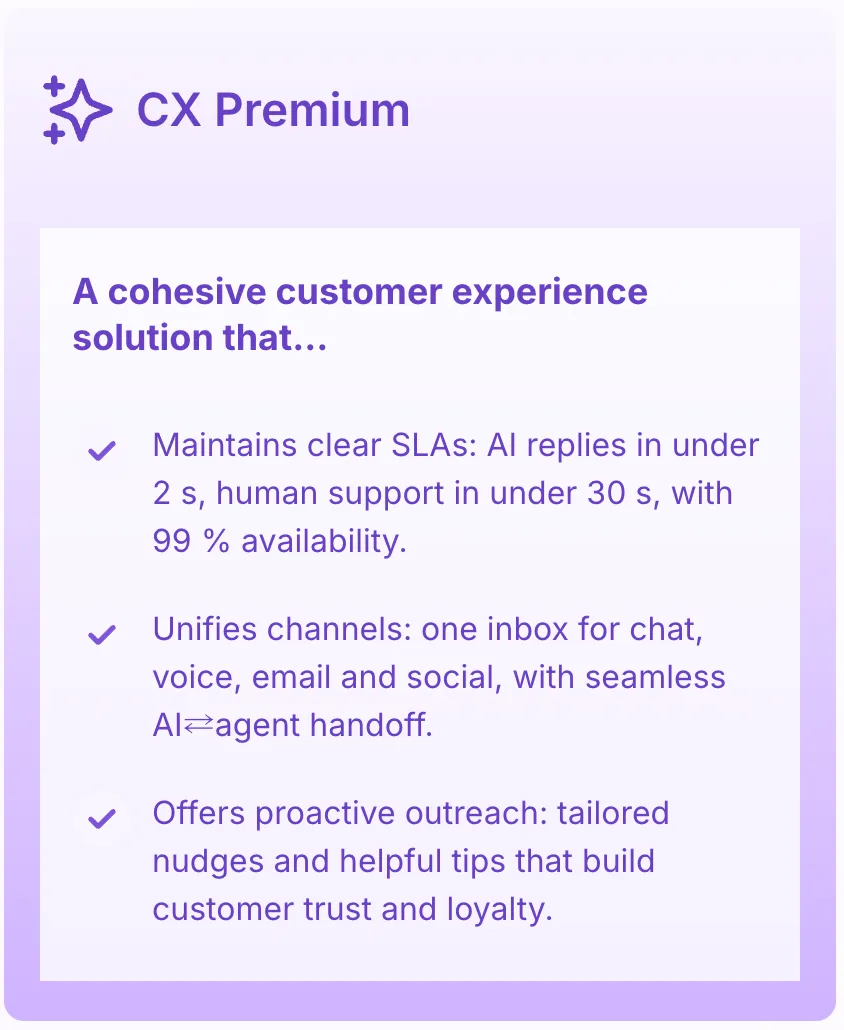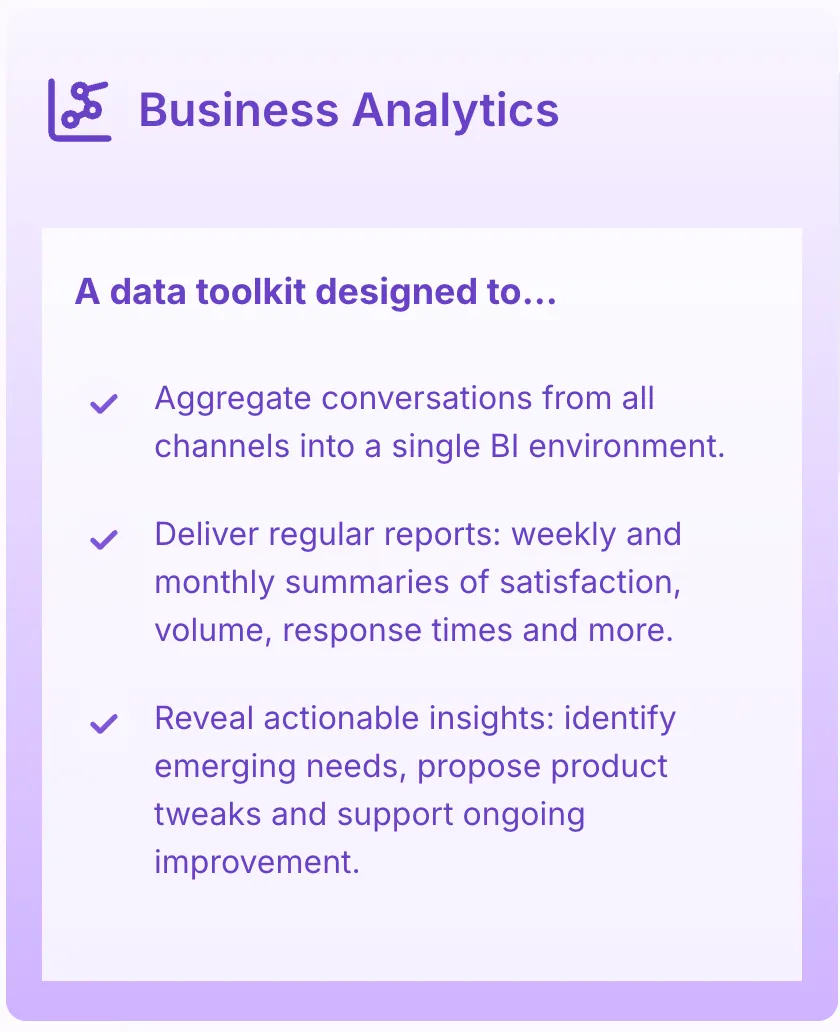The landscape of customer service has transformed dramatically in 2024. Today's customers demand:
- Instant responses across multiple channels
- Personalized interactions that reflect their preferences
- Seamless experiences from first contact to resolution
- 24/7 availability for support and assistance
Your ability to meet these expectations can make or break your business success. Research shows that 89% of companies now compete primarily on customer experience, marking a significant shift from traditional product-based competition.
A well-crafted customer service strategy drives more than just satisfaction metrics. It creates a ripple effect throughout your organization:
- Increased customer loyalty
- Higher revenue through repeat business
- Enhanced brand reputation
- Improved operational efficiency
- Stronger market positioning
The companies that thrive in 2024 recognize customer service isn't just a department—it's a critical business driver that shapes their entire organizational strategy.

Benefits of a Robust Customer Service Strategy
A well-crafted customer service strategy delivers substantial benefits that extend far beyond basic customer support. Let's explore these key advantages:
1. Enhanced Customer Satisfaction & Retention
- Happy customers become loyal advocates, with satisfied clients 3.5x more likely to repurchase
- Personalized interactions create emotional connections, reducing churn by up to 25%
- Consistent positive experiences build trust and long-term relationships
2. Increased ROI & Revenue Growth
- Loyal customers spend 67% more than new ones
- Upselling opportunities emerge naturally through quality service interactions
- Reduced acquisition costs as satisfied customers bring referrals
- Word-of-mouth marketing drives organic growth at minimal expense
3. Streamlined Operations & Cost Efficiency
- Automated systems handle routine inquiries, reducing operational costs
- AI-powered solutions provide 24/7 support without increased staffing
- Data-driven insights enable proactive problem-solving
- Standardized processes minimize errors and resource waste
4. Brand Reputation & Market Position
- Positive customer experiences generate authentic social proof
- Strong service reputation attracts premium customers
- Higher customer lifetime value through brand loyalty
- Competitive differentiation in crowded markets
5. Measurable Business Impact
- 84% of companies focusing on customer service report revenue increases
- Customer retention rates improve by 5% can boost profits by 25-95%
- Reduced support costs through efficient issue resolution
- Higher employee satisfaction and reduced turnover in service teams
A robust customer service strategy creates a positive feedback loop: satisfied customers drive revenue growth, operational efficiencies reduce costs, and strong brand reputation attracts new business opportunities. These benefits compound over time, creating sustainable competitive advantages in today's service-driven economy.
Key Elements of an Effective Customer Service Strategy
A successful customer service strategy starts with a clear vision that aligns with your company's core values. This vision acts as your guiding star, influencing every customer interaction and business decision. Your customer service vision should:
- Reflect your brand's unique identity and promise
- Set clear expectations for team behavior
- Define measurable success criteria
- Address specific customer needs in your market
Building a culture of service excellence requires intentional effort throughout your organization. Here's what makes it effective:
1. Cross-Departmental Integration
- Sales teams incorporate customer feedback into their pitches
- Product development uses support tickets to guide improvements
- Marketing creates content based on common customer questions
- IT prioritizes systems that enhance customer experience
2. Employee Empowerment
- Decision-making authority at the front lines
- Access to necessary tools and resources
- Regular skill development opportunities
- Recognition programs for exceptional service
Your customer-centric culture flourishes when every team member understands their role in delivering outstanding service. This involves breaking down barriers between departments and fostering shared accountability for customer satisfaction. Teams require ongoing training, clear communication channels, and the power to make decisions that prioritize customers.
Setting SMART Goals and Metrics to Measure Success in Customer Service Strategy
Implementing SMART goals (Specific, Measurable, Achievable, Relevant, Time-bound) creates a structured framework to track and enhance your customer service performance. Here's how key metrics align with SMART principles:
Customer Satisfaction Score (CSAT)
- Set specific satisfaction targets (e.g., "Achieve 90% CSAT within 6 months")
- Measure through post-interaction surveys
- Track progress weekly to identify improvement areas
Net Promoter Score (NPS)
- Define clear NPS growth targets
- Monitor customer likelihood to recommend your brand
- Break down feedback by customer segments for targeted improvements
Customer Effort Score (CES)
- Establish baseline CES measurements
- Set targets for reducing customer effort in specific interactions
- Track resolution time and number of touchpoints needed
Your SMART goals should reflect your unique business context. Examples include:
- "Reduce first response time by 25% within 3 months"
- "Increase self-service resolution rate to 40% by Q4"
- "Achieve 85% first contact resolution rate by year-end"
Regular measurement of these metrics enables data-driven decisions and helps identify areas needing immediate attention. Combining multiple metrics provides a comprehensive view of your customer service performance and guides strategic improvements.

Mapping the Customer Journey for Better Engagement
A customer journey map is a visual representation of every interaction between your customers and your business. It helps you understand how customers experience your brand, from the moment they become aware of it to post-purchase support.
This strategic tool allows you to:
- Identify critical touchpoints (key moments when customers interact with your brand)
- Understand pain points (areas where customers may be experiencing difficulties or frustrations)
- Discover opportunities for improvement in your service delivery
Key Components of Customer Journey Mapping:
- Touchpoint Identification: Document each interaction point from initial brand awareness through post-purchase support
- Customer Actions: Track specific steps customers take at each stage
- Customer Emotions: Record emotional responses during different interactions
- Pain Points: Highlight areas causing friction or frustration
- Opportunities: Identify potential areas for service enhancement
Creating an effective journey map requires input from multiple departments and data sources:
- Customer Feedback: Direct insights from surveys and interviews
- Analytics Data: Website behavior, app usage patterns
- Support Tickets: Common issues and resolution paths
- Sales Data: Purchase patterns and decision points
Your journey map should capture both digital and physical interactions:
- Website navigation
- Social media engagement
- Phone calls
- Email communications
- In-store experiences
- Mobile app interactions
By analyzing these touchpoints, you can identify service gaps and create targeted improvements. This detailed understanding enables you to anticipate customer needs and deliver proactive solutions before issues arise.
Regular updates to your journey map ensure it reflects changing customer behaviors and new service channels. This dynamic approach helps maintain alignment between your service delivery and evolving customer expectations.
Utilizing Feedback Channels for Continuous Improvement in Customer Service Strategy
Social media platforms serve as goldmines of customer feedback, offering real-time insights into customer sentiment and experiences. Your customers actively share their thoughts, complaints, and praise across platforms like Twitter, Facebook, and LinkedIn - creating valuable feedback touchpoints for your business.
Key Social Media Feedback Sources:
- Direct mentions and comments
- Private messages and DMs
- Product/service reviews
- Brand hashtag discussions
- Customer support interactions
A robust social listening strategy helps you capture and analyze these diverse feedback channels. Tools like sentiment analysis can process thousands of social media interactions to identify:
- Emerging customer pain points
- Common service gaps
- Positive experience patterns
- Brand perception trends
- Competition benchmarking data
Online review platforms add another critical dimension to your feedback ecosystem. Sites like Trustpilot, Google Reviews, and industry-specific platforms provide structured feedback that helps track service quality trends.
Actionable Steps for Feedback Implementation:
- Set up automated social listening tools
- Create dedicated teams for review response
- Develop feedback categorization systems
- Track sentiment changes over time
- Share insights across departments
The combination of social media engagement and review analysis creates a comprehensive view of your customer service performance. This data-driven approach enables quick identification of improvement areas and helps maintain service excellence.
Leveraging Technology to Optimize Customer Support Operations
Modern customer service strategy demands technological innovation to meet rising customer expectations. AI-powered chatbots have changed the game for support operations by providing instant, personalized assistance across various channels.
How Yellow.ai's AI Agents Are Leading the Way
Yellow.ai's AI agents are a prime example of this change, offering:
- 24/7 Availability: Automated responses to customer inquiries at any time, eliminating wait times
- Multi-Channel Support: Seamless integration across voice calls, live chat, email, and social media platforms
- Smart Routing: Intelligent distribution of complex queries to human agents while handling routine requests automatically
The Benefits of Implementing AI Chatbots in Customer Support
The use of AI chatbots in customer support strategy brings tangible advantages:
- Reduced Response Time: Instant answers to common questions
- Cost Efficiency: Lower operational expenses through automated handling of routine inquiries
- Scalability: Ability to handle multiple customer interactions simultaneously
- Consistent Service: Standardized responses maintaining quality across all interactions
How AI-Powered Systems Improve Over Time
AI-powered systems learn from each interaction, continuously improving their response accuracy and personalization capabilities. These technological solutions free up human agents to focus on complex issues requiring empathy and advanced problem-solving skills.
The Transformation of Support Models with AI Integration
The integration of AI chatbots transforms traditional support models into dynamic, responsive systems capable of meeting modern customer service demands while optimizing operational efficiency.

Advanced Analytics and Hyper-Personalization in Customer Service Strategy
Advanced analytics transforms raw customer data into actionable insights, enabling businesses to deliver highly personalized customer experiences. By analyzing customer behavior patterns, purchase history, and interaction preferences, companies can create tailored service approaches that resonate with individual customers.
Key Components of Analytics-Driven Personalization:
- Predictive Analytics: Anticipates customer needs based on historical data and behavior patterns
- Sentiment Analysis: Evaluates customer emotions and satisfaction levels across interactions
- Customer Segmentation: Groups customers based on shared characteristics for targeted service approaches
- Real-Time Decision Making: Enables immediate response to customer needs through data-driven insights
The implementation of advanced analytics helps service teams:
- Identify potential issues before they escalate
- Create personalized product recommendations
- Customize communication channels per customer preference
- Adjust service delivery based on individual customer history
Practical Applications:
"A customer who frequently contacts support about technical issues might automatically receive detailed technical documentation, while a customer who prefers quick solutions could be directed to video tutorials or chat support."
By leveraging machine learning algorithms, companies can analyze vast amounts of customer data to create dynamic customer profiles that evolve with each interaction. This deep understanding allows service teams to provide relevant solutions and personalized experiences that strengthen customer relationships and drive loyalty.
Building High-Performing Customer Service Teams Through Training and Empowerment Strategies
Building exceptional customer service teams starts with strategic recruitment. Successful organizations prioritize hiring individuals who embody their service-focused culture and demonstrate natural empathy, problem-solving abilities, and communication skills.
Key Recruitment Strategies:
- Behavioral interviewing techniques to assess cultural fit
- Skills assessment tests focusing on empathy and communication
- Multi-stage interview process including team interactions
- Reference checks emphasizing past customer service performance
The onboarding process transforms promising candidates into high-performing agents through structured training programs. Companies implementing comprehensive onboarding see up to 54% higher productivity from new hires.
Essential Onboarding Elements:
- Product knowledge and systems training
- Company values and service philosophy immersion
- Communication protocols and best practices
- Conflict resolution techniques
Role-play scenarios create a safe environment for agents to practice handling challenging situations. These simulations cover:
- Angry customer de-escalation
- Technical issue troubleshooting
- Complex problem resolution
- Multi-channel communication management
- Upselling and cross-selling opportunities
Ongoing Development Programs:
- Regular coaching sessions with team leaders
- Peer mentoring partnerships
- Performance review cycles
- Skill enhancement workshops
Employee empowerment plays a crucial role in building high-performing teams. Organizations that trust their agents to make decisions see increased customer satisfaction rates and faster resolution times.
Empowerment Strategies:
- Decision-making authority within defined parameters
- Access to necessary tools and resources
- Recognition programs for exceptional service
- Clear career advancement pathways
Regular feedback mechanisms help identify training gaps and improvement opportunities. Teams using data-driven performance metrics alongside qualitative assessments create targeted development plans for each agent.
Case Studies: Successful Companies with Effective Customer Service Strategies Using AI Tools Like Yellow.ai
Leading companies have transformed their customer service operations through AI-powered solutions like Yellow.ai. Here's how real businesses achieved remarkable results:
Lion Parcel - Logistics Excellence
- Implemented Yellow.ai's generative AI chatbots
- 85% reduction in customer service response time
- 24/7 automated tracking updates
- 40% decrease in support ticket volume
Global Retail Brand Success Story
- Deployed Yellow.ai's omnichannel support system
- 3x increase in customer satisfaction scores
- 60% of queries resolved through self-service options
- $2M annual cost savings in support operations
The Yellow.ai platform delivers these results through:
AI-Powered Automation
- Natural language processing for human-like conversations
- Smart routing based on query complexity
- Instant responses across multiple languages
- Proactive issue resolution
Analytics-Driven Insights
- Real-time customer behavior tracking
- Sentiment analysis for improved responses
- Personalization based on historical interactions
- Data-driven decision making for service improvements
Integration Capabilities
- Seamless connection with existing CRM systems
- Unified dashboard for all customer interactions
- Custom workflow automation
- API-first architecture for scalability
These implementations demonstrate how AI-driven customer service strategies create measurable business impact. Companies using Yellow.ai's platform report:
- 70% reduction in average handling time
- 90% automation of routine queries
- 45% increase in first-contact resolution
- 50% boost in agent productivity
The platform's self-service capabilities empower customers to find solutions independently, while sophisticated analytics ensure continuous service optimization and personalization.
Conclusion
The world of customer service is changing faster than ever. Businesses need to be flexible and use strategies that can adapt to new technologies and changing consumer behaviors. To have a successful customer service plan in 2024, you need:
- Continuous Innovation: Staying ahead with AI-driven solutions and automation
- Data-Driven Decision Making: Using analytics to understand and predict customer needs
- Agile Adaptation: Responding swiftly to market changes and customer preferences
- Human-Tech Balance: Blending technological efficiency with personalized human touch
Your customer service strategy should be flexible and grow with your business. The companies that succeed will be the ones that see their strategy as a journey that keeps evolving instead of a fixed goal. By being open-minded and paying attention to new technologies, you can better serve your customers now and in the future.
To provide outstanding customer service, you must be dedicated to evolving and innovating.
FAQs (Frequently Asked Questions)
What is a customer service strategy and why is it important in 2024 ?
A customer service strategy is a comprehensive plan that outlines how a business will deliver exceptional service to its customers. In 2024, its importance has grown significantly as it not only maximizes customer satisfaction but also drives organizational goals, ensuring long-term success in a competitive market.
How does a robust customer service strategy benefit businesses ?
A strong customer service strategy enhances customer satisfaction, leading to improved retention and loyalty. It increases ROI through upselling and new revenue streams, streamlines operations via automation for greater efficiency, and strengthens brand reputation, providing a competitive edge in the marketplace.
What are the key elements of an effective customer service strategy ?
Effective strategies are built on clear company values and a unified vision aligned with these values. They foster a culture of service excellence across all departments and prioritize creating a customer-centric environment that consistently meets and exceeds customer expectations.
How can setting SMART goals improve customer service outcomes ?
Setting SMART (Specific, Measurable, Achievable, Relevant, Time-bound) goals helps organizations focus on enhancing key metrics like Customer Satisfaction Score (CSAT), Net Promoter Score (NPS), and Customer Effort Score (CES). This targeted approach enables continuous improvement and measurable success in customer service delivery.
In what ways can technology optimize customer support operations ?
Technology such as AI-powered chatbots (e.g., Yellow.ai) provides responsive 24/7 support across multiple channels including voice, chat, and email. Integration of advanced analytics allows businesses to gain deep insights into customer behavior, enabling hyper-personalized experiences and more efficient support workflows.
How do companies build high-performing customer service teams ?
Successful companies recruit talent aligned with their culture of service excellence and provide comprehensive onboarding that includes role-play scenarios to prepare agents for real-world challenges. Continuous training and empowerment strategies ensure teams remain skilled, motivated, and capable of delivering exceptional customer experiences.









